Apples are one of the most popular fruits in the world.
However, there is more to apples than just ‘red’ and ‘green.’
In fact, there are hundreds of different apple cultivars, and all of them are slightly different.
This article looks at 17 popular types of apples, their characteristics, and their nutritional values.
How do they all compare?
The source of nutritional values is the USDA FoodData Central Database where available, and other sources include Nutritionix, My Food Diary, and Cronometer.
Types of Apples
1) Ambrosia
Ambrosia apples look like this:
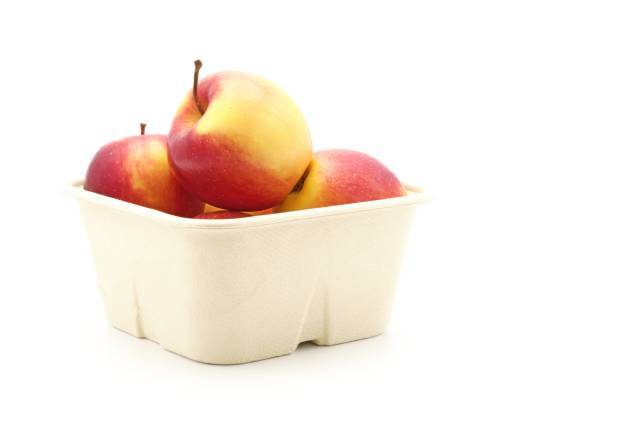
As shown, Ambrosia apples look partly red and partly green, with some areas containing a mix of the two colors.
These apples are one of the sweetest types of apples, and they have a crisp and crunchy texture with juicy flesh. In addition, Ambrosia apples have low acidity, so they don’t taste at all tart.
Also, Ambrosia apples tend to be quite large, and they weigh more than most other apples.
Quick Facts
- Common name: Ambrosia
- Scientific name: Malus domestica Ambrosia
- Origin: British Colombia, Canada
- Taste: Sweet, juicy
- Typical weight: 182g
Nutrition Facts
Here is the nutritional data for a medium (182g) ambrosia apple (1).
- Calories: 95 kcal
- Carbohydrates: 25g
- Fiber: 4.4g
- Sugars: 19g
- Fat: 0.3g
- Protein: 0.5g
2) Braeburn
Here is an image showing the typical look of a Braeburn apple:
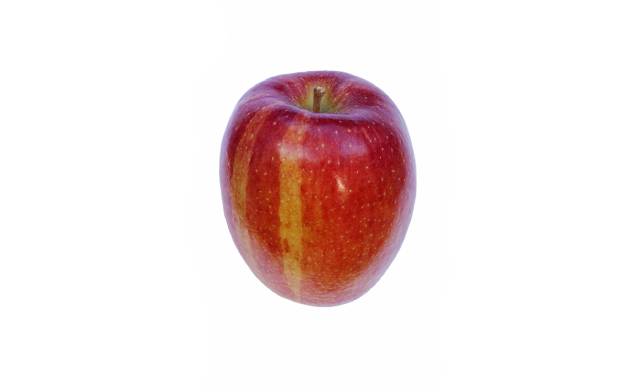
As shown in the picture, Braeburn apples are mainly red, with little bits of green coming through from the base in some areas.
Braeburn apples have a crisp, crunchy, and juicy texture, with a sweet and slightly tart taste.
The discovery of the Braeburn took place in 1952, and it is closely related to Granny Smith and Lady Hamilton apples (2).
Quick Facts
- Common name: Braeburn
- Scientific name: Malus domestica Braeburn
- Origin: Nelson, New Zealand
- Taste: Sweet, juicy, slightly tart
- Typical weight: 133g
Nutrition Facts
Here are the nutritional values for a medium (133-gram) Braeburn apple (3).
- Calories: 72 kcal
- Carbohydrates: 16g
- Fiber: 2.4g
- Sugars: 16g
- Fat: 0.1g
- Protein: 0.5g
3) Bramley
The image below shows the appearance of a typical Bramley apple:

Unlike most other apples, Bramley apples do not have a smooth and uniform shape. Instead, they have an uneven shape, and one side is often larger (or raised) than the other.
Bramley apples are also known as ‘cooking apples’ due to widespread culinary use. One reason why they are a popular cooking apple is their taste characteristics.
These apples are much tarter than other apples and very sour. Due to this, using them in cooking (which typically makes apples taste sweeter) helps retain the tart and tangy notes.
Generally speaking, Bramley apples are always used in cooking as they are too sour to eat raw.
Quick Facts
- Common name: Bramley
- Scientific name: Malus domestica Bramley’s Seedling
- Origin: Nottinghamshire, England
- Taste: Slight sweet notes but very tart, very sour
- Typical weight: 200g
Nutrition Facts
Here are the nutritional values for a regular-sized Bramley apple (200g) (4).
- Calories: 82 kcal
- Carbohydrates: 21g
- Fiber: 3.2g
- Sugars: 17.8g
- Fat: 0.2g
- Protein: 0.6g
4) Cortland
Below we can see what a regular Cortland apple looks like:
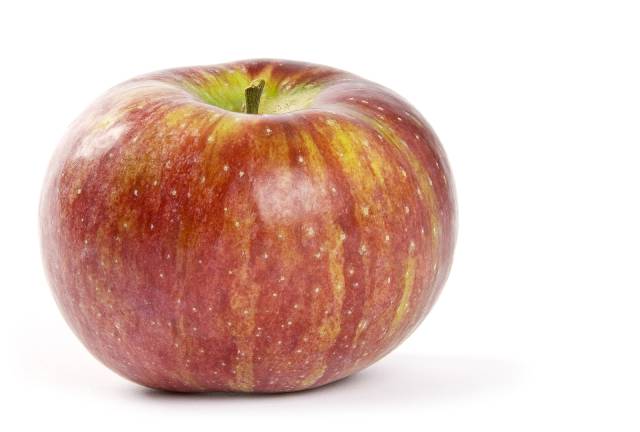
The apple has predominantly red skin, with slight shades of green in some areas.
Cortland apples come in all kinds of sizes, and they are one of the commonly found apples within the United States.
These apples have a crisp and crunchy texture, and they are partly sweet and partly tart in terms of taste.
Interestingly, Cortland apples were developed in New York during 1898 by crossing two existing apples; Ben Davis and Mcintosh (5).
Quick Facts
- Common name: Cortland
- Scientific name: Malus domestica Cortland
- Origin: New York, United States
- Taste: Slightly sweet yet partly tart
- Typical weight: 154g
Nutrition Facts
A typical Cortland apple has the following nutritional properties (6):
- Calories: 80 kcal
- Carbohydrates: 20.9g
- Fiber: 4.0g
- Sugars: 16.0g
- Fat: 0g
- Protein: 0g
5) Empire
Here is a picture of several Empire apples:
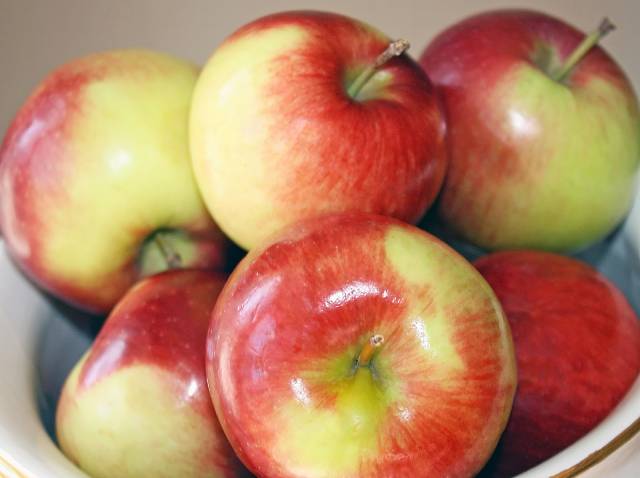
As we can see, the Empire apple is a smooth and shiny apple that is primarily red with tinges of green.
Like the last apple in this list, Empire apples originated in New York, United States.
These apples offer a crisp bite and firm, crunchy flesh. They taste very sweet.
Empire apples are yet another developed hybrid of two apple cultivars; McIntosh and Red Delicious (7).
Although they mainly grow in North America, they are exported worldwide.
Quick Facts
- Common name: Empire
- Scientific name: Malus domestica Empire
- Origin: New York, United States
- Taste: Sweet, firm
- Typical weight: 154g
Nutrition Facts
A regular Empire apple will have nutritional values as below (8):
- Calories: 80 kcal
- Carbohydrates: 22g
- Fiber: 4.9g
- Sugars: 16.0g
- Fat: 0g
- Protein: 0g
6) Fuji
The picture below shows a single Fuji apple:
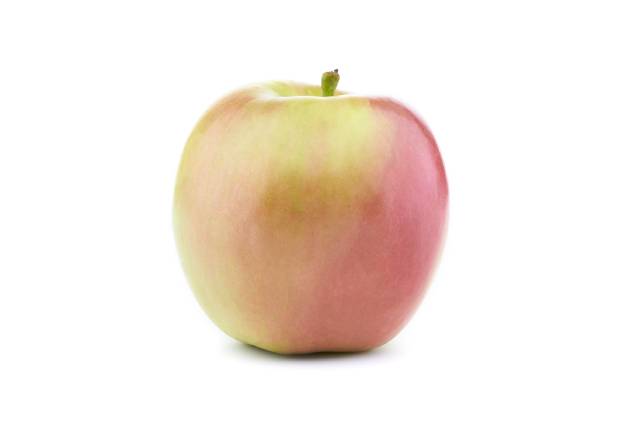
These apples have soft shades of red mixed with smaller yellow-green tones and a white-green inner flesh.
The Fuji apple originated in Aomori, Japan, in the late 1930s. Notably, it was Japan’s first cultivated apple (9).
These apples offer a crisp bite and firm, crunchy flesh. They taste very sweet, and they have only slight acidity.
Despite originating in Japan, growers now produce Fuji apples around the world.
Quick Facts
- Common name: Fuji
- Scientific name: Malus pumila Fuji
- Origin: Aomari, Japan
- Taste: Sweet, firm
- Typical weight: 192g
Nutrition Facts
A medium-sized (192-gram) Fuji apple has the following nutritional values (10):
- Calories: 121 kcal
- Carbohydrates: 29.2g
- Fiber: 4.0g
- Sugars: 22.5g
- Fat: 0g
- Protein: 0.4g
7) Gala
In the below image, we can see a whole and a half Gala apple:
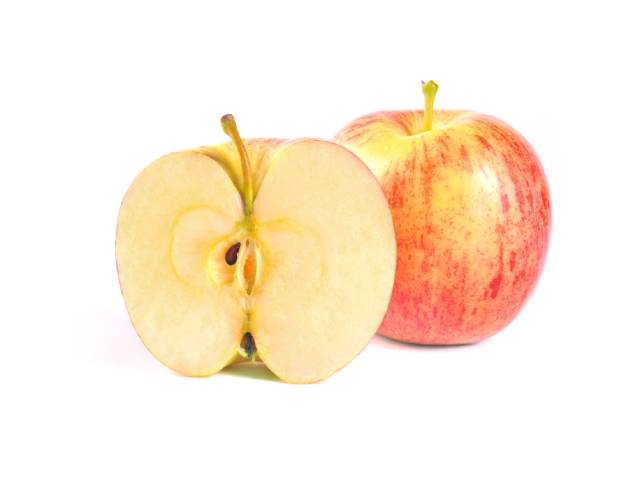
The outer skin has varying shades of green and red, and the inner flesh has a cream to light yellow tone.
Gala apples originated in Wairarapa, a region of New Zealand, in the 1930s, and they are one of the most popular apples globally (11).
These apples are also one of the most produced apples in the United States. After surpassing Red Delicious, Gala held the number 1 position for production based on 2019 and 2020 data (12).
Gala is one of the sweetest apple varieties, and they are also crunchy and very juicy.
Quick Facts
- Common name: Gala
- Scientific name: Malus domestia Gala
- Origin: Wairarapa, New Zealand
- Taste: Sweet
- Typical weight: 178g
Nutrition Facts
One medium Gala apple offers the following nutritional properties (13):
- Calories: 98 kcal
- Carbohydrates: 23.6g
- Fiber: 4.0g
- Sugars: 17.9g
- Fat: 0g
- Protein: 0.4g
8) Golden Delicious
The following image shows three Golden Delicious apples next to each other:
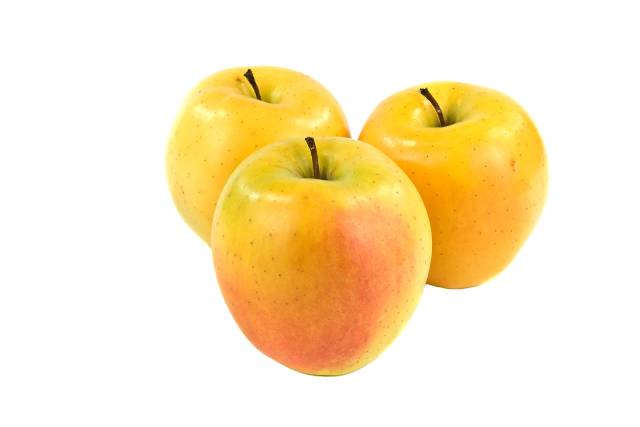
As shown in the photo, the apples have an attractive gold-like yellow and green color.
Golden Delicious is a North American apple, having first originated in West Virginia, United States, in the early 20th century (14).
The apples have a sweet taste with little acidity, and the flesh is crunchy and full of juice.
Golden Delicious is one of the most popular apples around the world.
Quick Facts
- Common name: Golden Delicious
- Scientific name: Malus domestica Golden Delicious
- Origin: West Virginia, United States
- Taste: Sweet, juicy
- Typical weight: 169g
Nutrition Facts
A medium Golden Delicious apple provides the following nutritional values (15):
- Calories: 96 kcal
- Carbohydrates: 23.0g
- Fiber: 4.1g
- Sugars: 16.9g
- Fat: 0.3g
- Protein: 0.5g
9) Granny Smith
Below we can see a single Granny Smith apple:
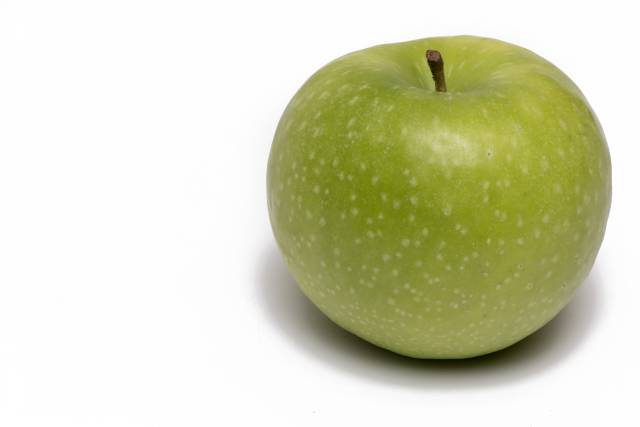
Granny Smith apples have a uniform green color, and it is a darker shade of green than most apples. The skin also has little white specks visible when looking at close range.
These apples are slightly tart and tangy, which may or may not be a good thing, depending on personal preference.
However, they also have a sweetness to them and a refreshing, juicy, and crisp texture.
The Granny Smith originated in New South Wales, Australia, in 1868, named after the lady who discovered it; Maria Ann Smith (16).
At present, Granny Smith apples are among the most produced types of apples globally. They have the fifth-highest production levels out of all apples in the United States (17).
Quick Facts
- Common name: Granny Smith
- Scientific name: Malus domestica Granny Smith
- Origin: New South Wales, Australia
- Taste: Sweet, slightly tart, juicy
- Typical weight: 167g
Nutrition Facts
Here are the typical nutritional values for a medium-sized (167-gram) Granny Smith apple (18):
- Calories: 97 kcal
- Carbohydrates: 22.7g
- Fiber: 4.7g
- Sugars: 16.0g
- Fat: 0.3g
- Protein: 0.7g
10) Honeycrisp
Two whole Honeycrisp apples and a half are shown in the image below:
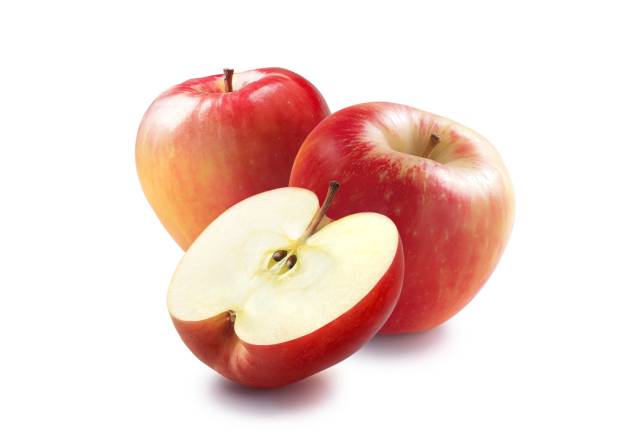
These apples have a red to pink shade covering a light-green base color, which shows in different proportions depending on the apple.
As their name suggests, Honeycrisp apples have a crisp texture and a sweet taste. The apples are very juicy too.
Interestingly, Honeycrisp apples originated through a cross-breeding program in 1960 but didn’t reach the market until 1991 (19).
In this short space of time, Honeycrisp apples became one of the most popular apples in the United States. In 2021, they had the third-highest production figures, only exceeded by Gala and Red Delicious (16).
Quick Facts
- Common name: Honeycrisp
- Scientific name: Malus pumila Honeycrisp
- Origin: Minnesota, United States
- Taste: Sweet, juicy
- Typical weight: 182g
Nutrition Facts
A typical medium (182-gram) Honeycrisp apple has the following nutritional properties (20):
- Calories: 95 kcal
- Carbohydrates: 25.0
- Fiber: 4.4g
- Sugars: 19.0g
- Fat: 0.3g
- Protein: 0.5g
11) Jazz
Here we can see a single red Jazz apple:
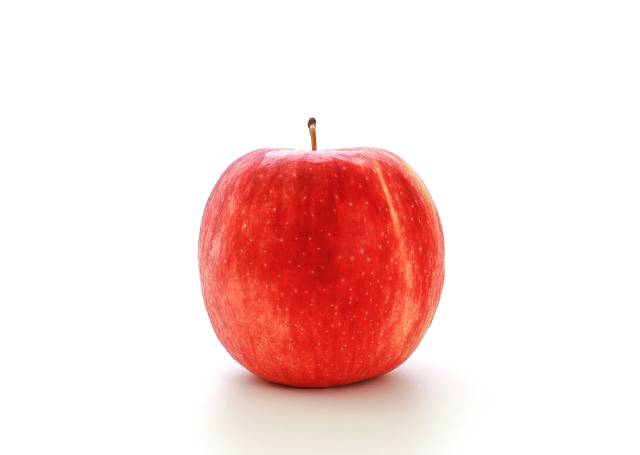
As the picture shows, Jazz apples have a bright red color with green-yellow base shades.
Jazz apples originated in New Zealand, and they are a cross between two highly popular apple cultivars; Braeburn and Gala (21).
Jazz apples are slightly tart but mainly sweet and juicy, with a crisp texture like their Braeburn and Gala ancestors.
Quick Facts
- Common name: Jazz
- Scientific name: Malus domestica Scifresh
- Origin: New Zealand
- Taste: Sweet, juicy, slight tart notes
- Typical weight: 182g
Nutrition Facts
Based on data from the Cronometer Community Database (CRDB), here are the nutritional values for a medium (154-gram) Jazz apple (22)
- Calories: 80 kcal
- Carbohydrates: 22.0
- Fiber: 5.0g
- Sugars: 16.0g
- Fat: 0g
- Protein: 0g
12) Jonagold
The image below shows three Jonagold apples on a wooden board:
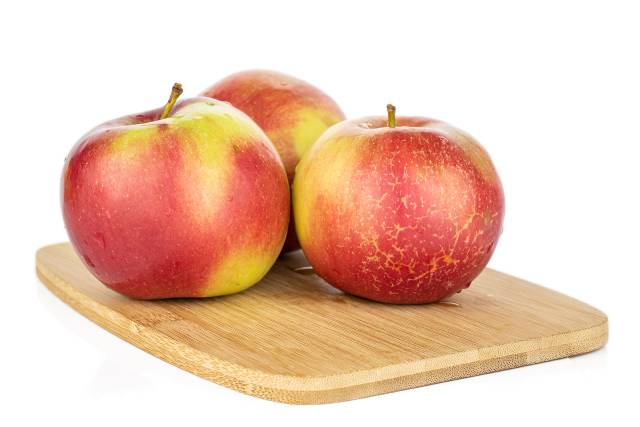
As the picture shows, Jazz apples have a greeny-yellow base color with shades of light red covering them.
Jonagold apples originated in New York in the 1950s, and it was a cross between the Golden Delicious and Jonathan apple (23).
Like the two apples that came before it, Jonagold apples have a mild, sweet, and juicy taste.
Quick Facts
- Common name: Jonagold
- Scientific name: Malus domestica Jonagold
- Origin: New York, USA
- Taste: Mild, sweet
- Typical weight: 154g
Nutrition Facts
Here are the typical nutritional values for a medium (154-gram) Jonagold apple (24):
- Calories: 80 kcal
- Carbohydrates: 22.0
- Fiber: 4.9g
- Sugars: 16.0g
- Fat: 0g
- Protein: 0.5g
13) McIntosh
We can see a single McIntosh apple in the image below:
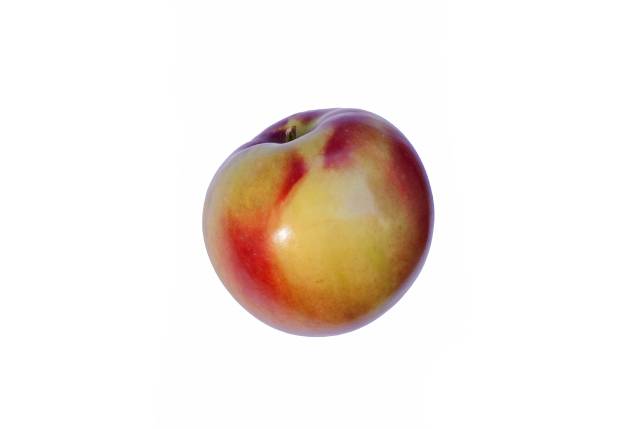
McIntosh apples have shades of crimson red, partially covering a light green base color.
These apples have been around for a long time, and their first discovery came back in 1811 in Ontario, Canada (25).
Perhaps more commonly known is that Apple Macintosh computers took their name from this McIntosh apple (26).
These apples are crunchy, juicy, and taste equal parts sweet and tart.
Quick Facts
- Common name: McIntosh
- Scientific name: Malus domestica McIntosh
- Origin: Ontario, Canada
- Taste: Sweet, tart, tangy
- Typical weight: 150g
Nutrition Facts
Using data from the CRDB nutrition database, here are the typical values for a medium (150-gram) McIntosh apple (22):
- Calories: 80 kcal
- Carbohydrates: 21.0g
- Fiber: 4.0g
- Sugars: 16.0g
- Fat: 0g
- Protein: 0.4g
14) Pink Lady
In the image below are two whole Pink Lady apples and half a pink lady, showing the inner flesh:
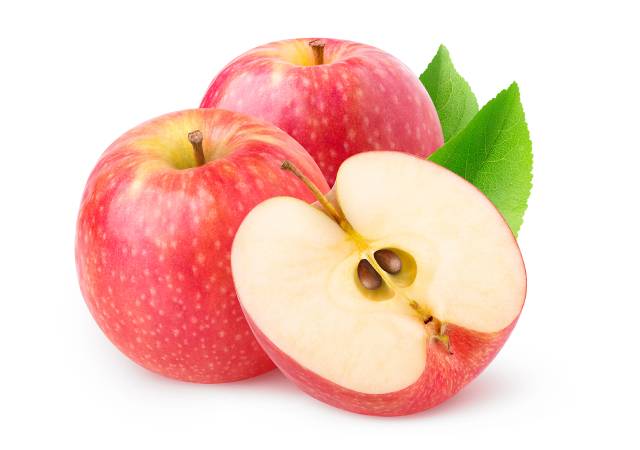
Pink Lady apples have an attractive pink-red color on top of a yellow-green base, with a cream to light yellow flesh.
The Pink Lady is among the tartest apple varieties, but it has a sweetness equal to its acidity.
Notably, Pink Lady apples were the first apple cultivar to receive a trademarked brand name for marketing purposes (23).
The apples originated in 1973 in Australia when they were developed by cross-breeding a Golden Delicious with a Lady Williams cultivar (24).
Despite Pink Lady’s branding, its scientific name of ‘Cripps Pink’ refers to its founder, John Cripps.
Quick Facts
- Common name: Pink Lady
- Scientific name: Malus domestica Cripps Pink
- Origin: Western Australia
- Taste: Sweet, tart, and juicy
- Typical weight: 133g
Nutrition Facts
The following data from the CRDB nutrition database shows the nutritional values of a regular 133-gram Pink Lady apple (22):
- Calories: 71 kcal
- Carbohydrates: 18.1g
- Fiber: 2.40g
- Sugars: 15.7g
- Fat: 0.10g
- Protein: 0.5g
15) Red Delicious
Here is an image of one single Red Delicious apple:
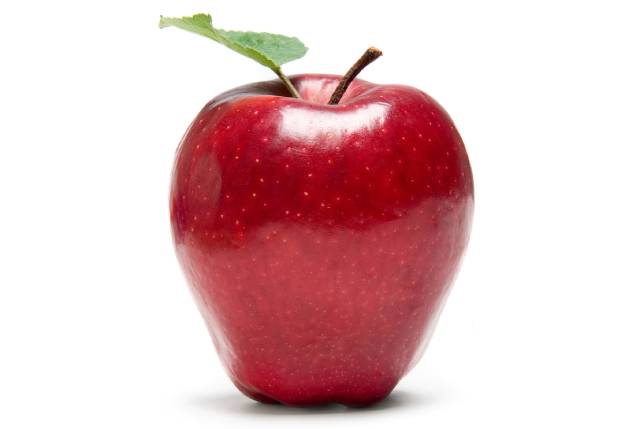
As we can see, the Red Delicious has a striking and bold bright crimson color, which is uniform around the apple.
The Red Delicious is one of the most popular apples, and it is a classic variety that came to fame at an International fruit show in 1893. However, the first discovery of the apple happened in 1872 (25, 26).
Red Delicious apples earned their ‘delicious’ name due to their unique new taste at the time.
The taste of a Red Delicious apple is mildly sweet.
Quick Facts
- Common name: Red Delicious
- Scientific name: Malus domestica Red Delicious
- Origin: Iowa, United States
- Taste: Mild, sweet
- Typical weight: 212g
Nutrition Facts
According to USDA data, one medium (212-gram) Red Delicious apple provides the following nutritional values (27):
- Calories: 125 kcal
- Carbohydrates: 29.9g
- Fiber: 4.9g
- Sugars: 22.3g
- Fat: 0.4g
- Protein: 0.6g
16) Russet
The following image shows one Russet apple:
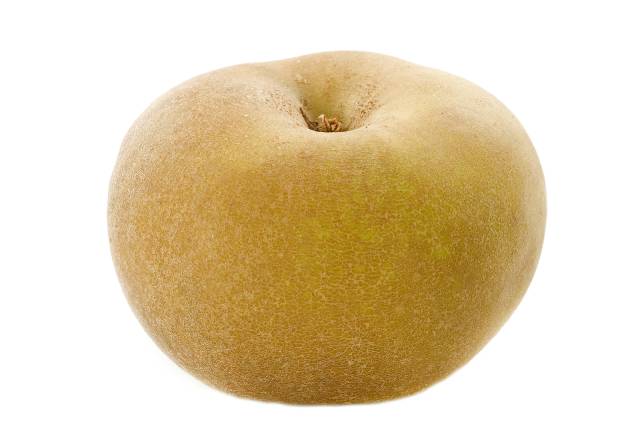
The picture shows that the Russet apple has a unique color and shape and looks quite dissimilar to other apples.
Russet apples have color that features brown, green, and yellow shades. Unlike most apples, the skin is not smooth, and it has a rough and scratchy texture.
The name ‘Russet’ refers to this rough, brownish skin that the apple develops.
There are numerous different varieties of Russet apple. Perhaps the most known of these is the Egremont Russet, which has an interesting nutty taste.
The Egremont Russet apple was officially discovered in 1872 in the United Kingdom (28)
Quick Facts
- Common name: Egremont Russet
- Scientific name: Malus domestica Egremont Russet
- Origin: Sussex, United Kingdom
- Taste: Nutty, slightly dry
- Typical weight: 150g
Nutrition Facts
Here are the nutritional values per 150-gram Egremont Russet apple (29):
- Calories: 80 kcal
- Carbohydrates: 21g
- Fiber: 4.0g
- Sugars: 16.0g
- Fat: 0g
- Protein: 0g
17) SweeTango
SweeTango apples are a relatively new apple cultivar, available since the year 2009 (30).
The apple is the result of breeding the Honeycrisp apple cultivar with a cultivar called Zestar.
These apples are said to taste ‘crisp and sweet, with a lively touch of citrus, honey and spice‘ (31).
It is worth noting that ‘SweeTango’ is the brand name of the apple, and the common name for the cultivar is Minneiska.
The SweeTango is also quickly increasing in popularity, with double-digit production growth rates for much of the past decade (32, 33).
Quick Facts
- Common name: SweeTango or Minneiska
- Scientific name: Malus domestica Minneiska
- Origin: Minnesota, United States
- Taste: Sweet, juicy
- Typical weight: 150g
Nutrition Facts
Below are the nutritional values for a 182-gram SweeTango apple (34):
- Calories: 95 kcal
- Carbohydrates: 25.0g
- Fiber: 4.4g
- Sugars: 19.0g
- Fat: 0.3g
- Protein: 0.5g
Frequently Asked Apple Questions
Here are some typical questions and answers that people may have about the different types of apples.
Many apples have a sweet taste, but some of the sweetest popular apples include Ambrosia, Fuji, Gala, Honeycrisp, and SweeTango.
Firstly, Bramley apples are very tart, but they are better suited to cooking and less enjoyable to eat alone. Among the most popular apples to eat out of hand, those with a tart taste include Braeburn, Granny Smith, and Pink Lady.
Apples have several good nutritional benefits, such as their provision of fiber. Additionally, apples provide a range of vitamins and minerals, although relatively modest amounts. Apples are also thought to score highly for their impact on satiety levels, and they may help with appetite control.
Final Thoughts
As shown in this article, there are numerous different apples to discover from around the world.
Each has its own distinct taste and texture characteristics, and all of these apples are enjoyable in their own right.
Related Articles
